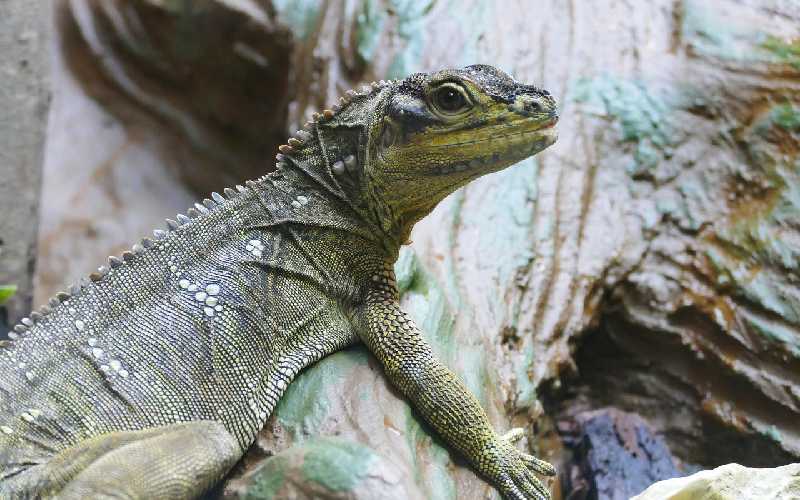Known as the closest in likeness to a pre-historic dinosaur, the sailfin dragon (Hadrosaurus pustulatus, H. Amboinensis and H. ”weberi”) has been a point of interest for many reptile owners.
Originating from Eastern Indonesia, the Philippines and New Guinea, the sailfin dragon is extremely large in size. Typically found basing near water, especially in or around mountain streams, this pre-historic looking reptile requires a lot of care.
Whilst they are loved by their community, the sailfin dragon is quite timid. Any sense of danger will cause them to run away – especially in their natural habitat – including on top of the water until they sink and swim.
That leaves the question: what kind of enclosure is required for a sailfin dragon pet?
Sailfin Dragon Size
Before we go into detail on the types of enclosure required to keep such a reptile safe and comfortable, we need to understand the size of the sailfin dragon.
As you can imagine, their pre-historic features that any enthusiast will marvel over suggest how large they can come to be. With its considerable body and elongated tail, the sailfin dragon is similar to its big lizard species friends.
The average size of an adult sailfin dragon can spread up to 3 feet in length. Males will typically be 33% larger than their female counterparts, however, female sailfin dragons will still span a great length.
Enclosure Size
As a young lizard, the sailfin won’t need a giant enclosure – a 30–50-gallon terrarium will suffice perfectly fine. However, any standard size lizard aquarium that is secure and spacious enough will be great.
With this said, they are a very large reptile and whilst averaging around 3 feet in size, can grow up to 4 feet or more. A standard enclosure won’t cut it for this.
Your adult sailfin dragon will need a large enclosure with metrics of 5×2/3×5. That’s 5 feet long, 2-3 feet wide and five feet tall. However, this will be the smallest you would want to go for a lizard of this size.
If you want to make your sailfin dragon extra happy, then 6x3x6 would ensure that their home is comfortable.
What material to use?
As mentioned earlier, Sailfin dragons can be extremely timid and as a result, look to flee. Therefore, you need to control the sight area of your enclosure.
Solid opaque materials on the back and sides of the enclosure that restrict any view will make sure that your lizard can only see out of one area. In this area, you’ll want to keep in mind what is in view.
So, what else do you need?
Moisture absorbing Substrate
Cypress mulch is the safest option to choose as your substrate. It is easy to clean and holds the moisture effectively to keep humidity levels at an equilibrium.
Ensure that your substrate is nice and large, especially larger than sand, as it can get stuck in and around the reptile’s eyes.
Branches
Lay diagonal and horizontal branches to give your sailfin dragon an ample amount of room to climb with many different routes. When picking out your branches, ensure that they are thick to support the weight and size of their occupant. However, you’ll want to make sure you don’t overfill the enclosure with branches as it could cause pinching should you sailfin dragon land awkwardly or become trapped.
Along with your branches, you’ll want to place some foliage around the enclosure. Some artificial or real plants should cover the base of the habitat. Just like with the branches, don’t overfill the enclosure, as your lizard will need room to run around.
Temperature
Sailfin dragons can thermoregulate. In their natural habitat, they can move to different places with varying temperatures to self-regulate their body temperature.
To replicate this, create a temperature gradient with your lights that ensure there are different temperature spots for your lizard to relax in.
Your optimal temperature will be around 115-120 degrees Fahrenheit whereas other areas will need to be considerably lower at around 80-90 degrees Fahrenheit.
With your lighting, it is crucial to obtain a UVB lamp that can simulate the suns rays. They will need this to gain the correct about of UV exposure that will help to synthesize calcium in their bodies.
With this, these creatures will also need a day and night cycle. Simply, set your lights on timers to off at night to replicate their real-world habitat.
Water
To replicate their home environment, Sailfin dragons will need to be close to fresh, clean water inside their enclosure.
A large pan of water sitting at the bottom of their enclosure will ensure that your lizard can dip in for a soak. The water must be fresh so make sure to clean the enclosure daily – including replacing its water.
If you enjoyed this article you might also like to read about Sailfin Lizard Care and Sailfin Dragon Size


3 thoughts on “Sailfin Dragon Enclosure”